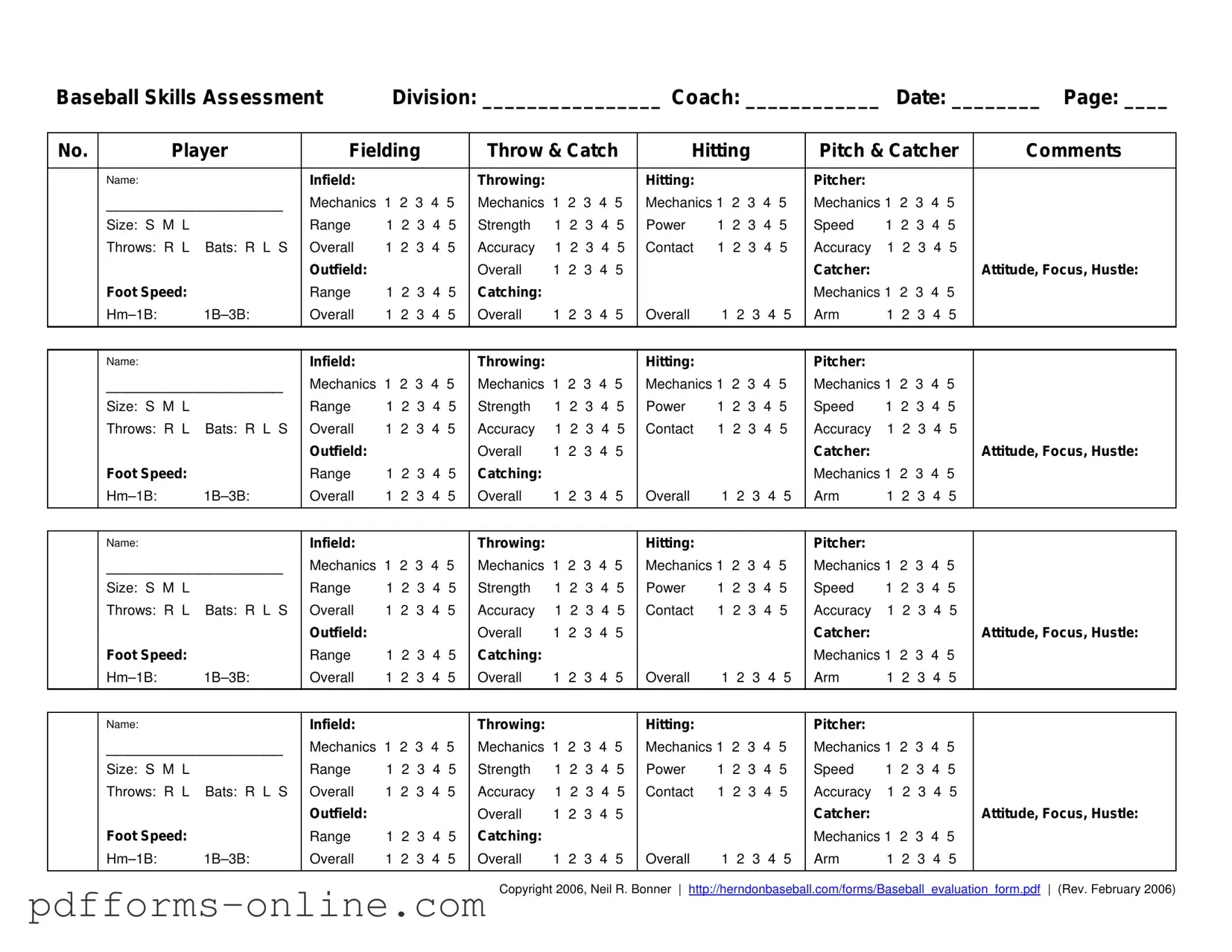The Soccer Skills Assessment Form serves a similar purpose to the Baseball Assessment form, focusing on evaluating players' abilities in various skills essential for soccer. Like the baseball form, it includes sections for different skill sets such as dribbling, passing, shooting, and defensive skills. Coaches can score players on a scale, providing a structured way to assess their performance and compare it against their peers. This form is often used during tryouts and team selections, ensuring that evaluations are fair and consistent across all players.
The Basketball Skills Evaluation Form is another document that mirrors the Baseball Assessment form. It assesses players on fundamental basketball skills such as dribbling, shooting, passing, and defense. Coaches use a scoring system to rate players, similar to the five-point scale found in the baseball form. This allows for a clear comparison of players' skills, making it easier for coaches to make informed decisions during tryouts and team formations.
The Football Skills Assessment Form is also akin to the Baseball Assessment form, focusing on evaluating players' abilities in key football skills like passing, receiving, tackling, and blocking. Coaches can score players in various categories, which helps in identifying strengths and areas for improvement. The structured format allows for a comprehensive evaluation, ensuring that coaches have a well-rounded view of each player's capabilities.
The Softball Skills Evaluation Form shares similarities with the Baseball Assessment form, as both sports require similar skill sets. This form evaluates players on their hitting, fielding, and pitching abilities. Coaches utilize a scoring system to rate players, providing a standardized way to assess performance during tryouts. The structure helps ensure that all players are evaluated fairly, making it easier to form balanced teams.
The Volleyball Skills Assessment Form is another document that resembles the Baseball Assessment form. It evaluates players on skills such as serving, passing, setting, and attacking. Coaches can score players based on their performance, which helps in determining team placements and identifying areas for improvement. This structured approach ensures that evaluations are consistent and comprehensive, much like the baseball assessment.
The Hockey Skills Assessment Form parallels the Baseball Assessment form by evaluating players on essential hockey skills like skating, shooting, and passing. Coaches score players on a scale, allowing for a clear comparison of skills among team members. This structured evaluation process helps coaches make informed decisions during team selections, ensuring that players are placed in positions that best suit their abilities.
The Track and Field Skills Evaluation Form also shares similarities with the Baseball Assessment form. It assesses athletes on various track and field events, such as sprinting, long jump, and shot put. Coaches can use a scoring system to evaluate performance, allowing for a fair comparison among athletes. This structured format helps coaches identify strengths and weaknesses, guiding training and competition strategies.
The Swimming Skills Assessment Form is another document that mirrors the Baseball Assessment form, focusing on evaluating swimmers' abilities in different strokes and techniques. Coaches score swimmers based on their performance in various events, providing a standardized way to assess skill levels. This structured approach helps ensure that swimmers are placed in appropriate training groups and competitions, similar to how baseball players are evaluated for team placements.
The Gymnastics Skills Evaluation Form is similar to the Baseball Assessment form in that it assesses athletes on specific skills required for gymnastics routines. Coaches evaluate gymnasts on their performance in areas such as balance, flexibility, and strength. A scoring system is used to provide a clear comparison of abilities, ensuring that evaluations are consistent and fair across all participants.
For those interested in understanding the process of ownership transfer, the simple Tractor Bill of Sale example is an invaluable resource outlining critical components to ensure a successful transaction.
Finally, the Dance Skills Assessment Form resembles the Baseball Assessment form by evaluating dancers on their technique, style, and performance. Coaches use a scoring system to assess dancers' abilities in various dance styles, allowing for a structured evaluation process. This helps ensure that dancers are placed in appropriate classes or performance groups, similar to how baseball players are evaluated for team selection.

